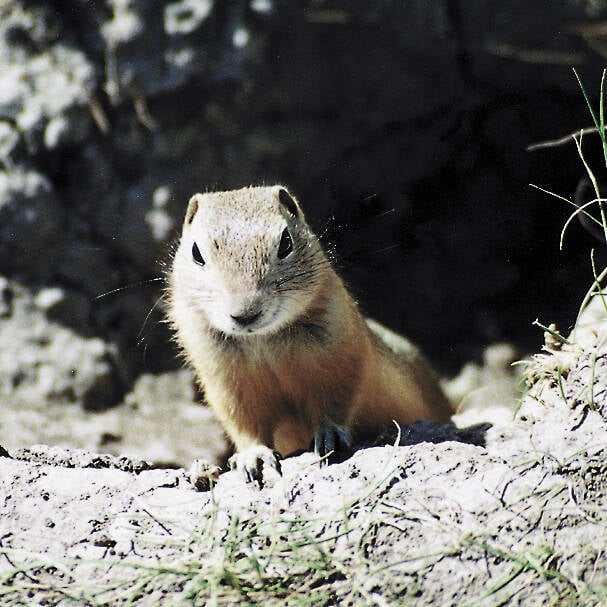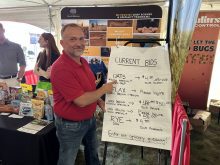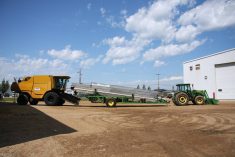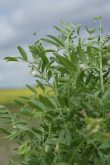Some farmers and researchers see strip till as an alternative to zero till on lighter soil, while others see it as an alternative to conventional till on heavy soil.
Laura Overstreet of North Dakota State University in Fargo, N.D., says hot spring winds can rip young seedlings out of the soil under conventional tillage in the Red River Valley.
“When we have an early spring wind event in the Red River Valley, we routinely lose 15 percent of the seedlings,” she said.
“The seedlings are just starting to put down their roots. When we get those dry winds in the range of 25 to 35 km/h, it actually pulls seedlings out of the ground. In conventional tillage, they have no protection from the wind.
Read Also

Sask. ag group wants strychnine back
The Agricultural Producers Association of Saskatchewan has written to the federal government asking for emergency use of strychnine to control gophers
“Unless you’re down on your knees counting and measuring, you’ll never even notice the loss, but it’s real and it does happen routinely.”
Uprooted and broken plants are hard to spot because they quickly wither to nothing in the hot wind and blow away, she added.
Overstreet, who presented her research to the Manitoba Soil Science Society in Winnipeg Feb. 4, has been comparing strip and conventional till with a chisel plow in the Red River Valley. Crops include wheat, corn, soybean and sugar beets.
“Another factor is broken stems. When the plant emerges, the cotyledon has these leaves that are very large compared to the stalk and roots,” she said.
“The leaves act like a pinwheel. Wind catches them and twists them around and snaps them off. The leaves blow away and the plant is dead. It happens in corn, soybeans, sugar beets and any other crop we grow under conventional tillage in the valley.”
Overstreet said wind also removes the most valuable soil from the field, along with expensive fertilizer and pre-plant chemicals. She includes wheat in all her rotations because it provides the best wind protection and is a good residue in which to seed the next crop.
Many Canadian prairie farmers are accustomed to leaving wheat stubble as high as 12 inches, but Overstreet has found that even four to six inches is enough to provide wind protection in the inter-row area between strip till seed rows.
Fuel consumption is a major consideration when comparing strip and conventional tillage.
Under strip till, producers can put down all fertilizer and pre-plant chemicals in a single pass that covers only 40 percent of the field surface. Overstreet called this a low-energy tillage pass.
Conventional till with a chisel plow, on the other hand, requires three to five high energy passes to prepare the seedbed.
On Manitoba and North Dakota’s calcareous soils, phosphorus is tied up by the minerals when it’s broadcast in a conventional system.
“But when you band your phosphorus with strip tillage, you put it right where the crop can use it. Research shows you can cut your phosphorus requirements by 20 to 30 percent when banding.”
Overstreet said the industry is still debating the need for RTK caliber GPS steering guidance. Some farmers she’s talked to say it’s absolutely essential to put the seed row right down the middle of the tilled strip with high tech guidance.
“Other farmers don’t use GPS and they say it’s OK. The tilled strip is eight to 12 inches wide, so they say they can keep the planter pretty close to the centre.”
Strip till has shown a major soil temperature benefit over zero till farther west at Carrington N.D., but the temperature advantage almost disappears when comparing strip till to conventional tillage with a chisel plow.
Early spring soil temperatures are the most significant to growing a good crop of corn, soybeans or sugar beets. Overstreet said the most important soil temperature readings are late April and early May, right after seeding.
The soil temperature advantage for strip till was only 0.5 to 1.5 C for the first four weeks after seeding. These reading were taken at a two-inch depth at the warmest time of the day.
Overstreet said the higher strip till temperatures are consistent throughout her research, but the difference does not provide a significant benefit.
However, strip till does produce higher soil moisture levels in the inter-row area, which she thinks proves better soil moisture retention with strip till. She wants another year of research to back her findings.
Overstreet said early season plant health is important.
“What happens at seeding determines what will happen through the entire growing season. We’ve shown that strip till gives a warmer, well-fractured seedbed and better seed-to-soil contact. This all creates a better early growth environment for the seedling.”
For more information, contact Laura Overstreet at laura.overstreet@ndsu.edu.

















